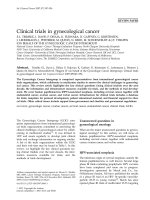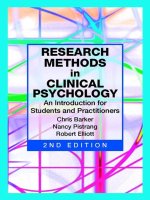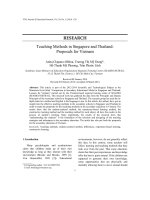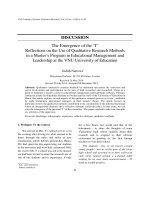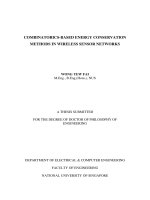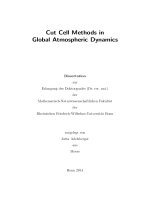PT Wakode - Clinical Methods in ENT[Ussama Maqbool]
Bạn đang xem bản rút gọn của tài liệu. Xem và tải ngay bản đầy đủ của tài liệu tại đây (3.02 MB, 171 trang )
Clinical Methods
in
ENT
Clinical Methods
in
ENT
PT Wakode
Professor of ENT
VN Government College
Yavatmal
JAYPEE BROTHERS
MEDICAL PUBLISHERS (P) LTD
New Delhi
Published by
Jitendar P Vij
Jaypee Brothers Medical Publishers (P) Ltd
EMCA House, 23/23B Ansari Road, Daryaganj
New Delhi 110 002, India
Phones: 3272143, 3272703, 3282021, 3245672, 3245683
Fax: 011-3276490 e-mail:
Visit our website:
Branches
• 202 Batavia Chambers, 8 Kumara Kruppa Road, Kumara Park East
Bangalore 560 001, Phones: 2285971, 2382956 Tele Fax: 2281761
e-mail:
• 282 IIIrd Floor, Khaleel Shirazi Estate, Fountain Plaza
Pantheon Road, Chennai 600 008, Phone: 8262665 Fax: 8262331
e-mail:
• 4-2-1067/1-3, Ist Floor, Balaji Building, Ramkote Cross Road
Hyderabad 500 095, Phones: 6590020, 4758498 Fax: 4758499
e-mail:
• 1A Indian Mirror Street, Wellington Square
Kolkata 700 013, Phone: 2451926 Fax: 2456075
e-mail:
• 106 Amit Industrial Estate, 61 Dr SS Rao Road, Near MGM Hospital
Parel, Mumbai 400 012 , Phones: 4124863, 4104532 Fax: 4160828
e-mail:
Clinical Methods in ENT
© 2002, PT Wakode
All rights reserved. No part of this publication should be reproduced, stored in a retrieval system, or
transmitted in any form or by any means: electronic, mechanical, photocopying, recording, or
otherwise, without the prior written permission of the author and the publisher.
This book has been published in good faith that the material provided by author is original. Every effort
is made to ensure accuracy of material, but the publisher, printer and author will not be held
responsible for any inadvertent error(s). In case of any dispute, all legal matters to be settled under
Delhi jurisdiction only.
First Edition: 2002
Publishing Director: RK Yadav
ISBN 81-7179-940-X
Typeset at JPBMP typesetting unit
Printed at Gopsons Paper Ltd, Noida
preface
It would not be an exaggeration if I say that otolaryngology is the specialty, which
has grown spell and bound, in the last 25 years. Few years’ back ENT was supposed
to be a branch of surgery for tonsil and submucous resection of septum. This is no
longer true. ENT has made inroads, which comprise from dura to pleura. With the
advent of newer technologies like micro ear surgery, laser surgery and functional
endoscopic sinus surgery, otolaryngology is usurping the newer records of state of
art. A medical student who is going to treat the patients in 21st century can’t afford
to lag behind.
While teaching undergraduate students I always felt the necessity of a book
based on clinical teaching in ENT. There are large many textbooks on ENT written
by senior authors. But they do not satisfy the need of students as to “ How to
examine an ENT patient?” Books to this effect are written for General Surgery and
Medicine. Even though the basic principles of examining the patient remain the
same, the specialty of otolaryngology differs in many respects. There was a gap
between a novice student and field of otolaryngology. It was my desire to fill up this
gap.
I am sure that this book would be immensely useful to the undergraduate
students who are doing clinical posting in ENT. It would give them insight to patient
examination. The book would be equally useful to residents who are working in
ENT. The book is illustrated nicely with 163 coloured photographs of various clinical
conditions. Diagrams and charts given in the book should be useful to the students
in clinical learning. An attempt is also made to teach the relevant radiology to the
student.
I owe beyond words to my wife Mrs Bharati Wakode who could tolerate my
masterly inactivity in household matters due to pre-occupation in this book.
Dr Surendra Gawarle, Associate Professor, in ENT has all the time helped me in
giving positive criticism on various aspects of the book. Dr Samir Joshi, Lecturer in
my department was always ready to help me in preparing the photographs, text
and any other help needed to me from time to time. Dr Dilip Sarate, a Pathologist
has drawn beautiful diagrams for the book and definitely needs to be mentioned.
Dr Pawan Tekade, my House Officer has given his co-operation in digital photography.
It would be my pleasure to see this book in the hands of students attending the
ENT clinics.
PT Wakode
foreword
It is a great delight for me to write a brief introduction to Professor Wakode’s
excellent textbook Clinical Methods in ENT. It was my great pleasure in 1988 to
welcome Professor Wakode to Southampton on a Commonwealth Medical Fellowship
sponsored by the British Council and Association of Commonwealth Universities.
My particular expertise is in medical laser applications in ENT and certain other
specialties and I very much enjoyed teaching him “all I know about lasers” and he
was also a most valuable member of our Clinical Department. I have followed his
career since his return to India and I am delighted to know of his appointment as
Professor of ENT in Yavatmal.
This textbook is designed for undergraduate students and will also be of great
value to any doctor in any grade wishing to improve his knowledge of clinical methods
in otolaryngology. I wish this book every success.
John Carruth MA MB PhD FRCS
Southampton, UK
contents
Part I
1. Introduction ....................................................................................................3
2. History Taking ............................................................................................... 8
3. Examination of Swelling, Ulcer and Fistula .........................................12
Part II
4. Examination of Ear .....................................................................................23
Part III
5. Examination of Nose and Paranasal Sinuses ....................................... 59
Part IV
Section A
6. Oral Cavity and Oropharynx ....................................................................89
7. Examination of Larynx and Laryngopharynx .................................. 103
Section B
8. Examination of Neck ............................................................................... 113
9. Examination of Salivary Glands ........................................................... 125
Section C
10. Diseases of Oesophagus .......................................................................... 129
11. Tracheo-bronchial Tree .......................................................................... 136
Part V
12. Examination of Cranial Nerves ............................................................. 145
Index ............................................................................................................... 161
Clinical Methods
in
ENT
Distinguishing Features:
• Designed for undergraduate students and practitioners
wishing to improve knowledge of clinical methods in
otolaryngology.
• Gives insight to patient examination ‘How to examine an
ENT patient’.
• Beautifully illustrated with 163 coloured photographs of
various clinical conditions.
• Quite a good number of diagrams and charts for the benefit
of students in clinical learning.
• Helpful in learning relevant radiology to the students.
JPB Rs.350.00
81-7179-940-X
JAYPEE BROTHERS
MEDICAL PUBLISHERS (P) LTD
EMCA House, 23/23B Ansari Road, Daryaganj
New Delhi 110 002, India
PART I
one
introduction
Dear students by the time you are posted in ENT you have already completed your
clinical posting in General Surgery and General Medicine. So you are well acquainted
with patient’s history taking. Let me tell you that though basic principles remain
the same, the clinical examination in ENT is a bit different from what you have
learnt so far. And this is so because Ear, Nose and Throat are small darker cavities
in the human body. They are partially hidden and to examine them you need good
illumination. Not only that but these are very sensitive parts of the body and while
examining them one has to have a “ feathery touch” and some patience also. Because
many a times even with utmost care, patient does not co-operate in the examination.
One more difference is that the teacher can teach you how to examine a tumor on
hand, foot or even abdomen and more than one student can see it simultaneously.
But this is not the case in ENT. It is very difficult to examine the patient by two
people simultaneously because of small and relatively inaccessible anatomical areas.
And hence one has to put more efforts to be proficient in the ENT examinations.
Let me say that it is a scientific art.
So before we actually embark on the clinical examination it is better, if we get
acquainted with various instruments commonly needed to examine a patient.
Bull’s Eye Lamp
This is the most important instrument for
proper illumination of the relatively darker
cavities like ear, nose and throat. It consists
of a heavy base, stand and a cylindrical box.
This box contains an electrical bulb and a
powerful convex lens. Electrical bulb should
be milky white so that you get a good
circular focus.
Head Mirror
Figure 1.1: Bull’s eye lamp
This is another important equipment needed. It has a circular concave mirror and
a headband attached to it. It has a central hole of diametre of approximately 2 cm
through which examiner can see. The concave mirror has focal length of
approximately 23.6 cm. The headband is fixed to the head and then the concave
mirror is held close to the right eye completely covering it. Examiner closes his left
4
CLINICAL METHODS IN ENT
eye and focuses the light on the patient’s
body. Then he sees with his right eye
through the central hole. Once he gets a
good focus he opens his left eye and examines the patient by keeping both eyes
open. With little practice this becomes a
routine. Light coming from the Bull’s eye
lamp is reflected from the head mirror on
the patient’s body. As the rays focussed
on the patient are parallel to visual axis
you get the very good illumination. Your
both hands are free for various manipulaFigure 1.2: Head mirror
tions like syringing or removal of foreign
body, etc. This illumination system is best
in the present circumstances. Torch, or otoscopes are in the use but these
instruments keep your hand engaged and manipulations like removal of wax, FB,
etc. are not possible. Hence this lighting system is popular all over the world.
Aural Speculum
This instrument is used to examine the ear canal and
tympanic membrane. They are polished from outside but
having dull finish inside so that they do not reflect much
light to cause glare. Black finish ear speculums are used
in operation theatre for the same reason. Aural speculum
of appropriate size should be chosen and negotiated in
the ear canal. It should pass easily the junction of bone Figure 1.3: Aural speculum
and cartilage. It should be snugly fitting, not too large or
too small for the ear under examination.
Nasal Speculum
Thudicum’s nasal speculum is in
the common use. It has blades and
a U shaped metallic strip to hold the
instrument. Nasal speculum of
appropriate size should be chosen.
It should be always held in the left
hand with the blades of the instrument facing the patient. Left index
finger and thumb hold the instrument and left middle and ring finger
controls the movements of blades.
Figure 1.4: Nasal speculum
INTRODUCTION
5
Slowly it is negotiated in the patient’s nostril without hurting the patient. You can
examine nasal septum, turbinates and any abnormality in the nose with the help of
this instrument. Long bladed instrument may be painful and should not be used
without anaesthesia.
Laryngeal Mirrors
These are small plane mirrors fixed in a circular metallic
bracket. They are used to examine the larynx and
pharynx, which is other wise inaccessible for examination.
They have a small handle to hold the instrument. The
Figure 1.5: Laryngeal
mirror is gently heated before doing the examination. This
mirror
is to prevent condensation of patient’s breath on the
mirror. As you don’t see the actual larynx but a mirror image the procedure is
known as Indirect Laryngoscopy.
Postnasal Mirrors
These mirrors are similar to laryngeal mirrors but smaller in size and the handle is
not straight. It is having two bends in it. This is to suit the instrument in the
postnasal space and to keep the hand of clinician away from the visual field while
examining. This examination is called as Posterior Rhinoscopy popularly known as
PR examination.
Figure 1.6: Postnasal mirrors
Siegle’s Speculum
This instrument is having a rubber bulb, rubber
tubing and an adapter that can be attached to an
ear speculum. The adapter has fitted in it a convex
lens having a magnification of 2X.
Uses
1. To see a magnified view of the tympanic membrane.
2. To elicit the mobility of tympanic membrane.
3. To elicit fistula test.
Figure 1.7: Siegle’s speculum
6
CLINICAL METHODS IN ENT
Tuning Forks
Tuning forks of 256, 512 and 1024 Hertz are used in ENT
practice. They are different from the tuning forks used by
physicist. Medical tuning forks have a strong metallic base,
stem and prongs. They are used to perform hearing tests like
Rinnie test, Weber test, etc.
Wire Vectis with Cerumen Spud
This instrument is used for removal of FB/wax in clinical
practice.
Figure 1.8: Tuning
forks
Figure 1.9: Wire vectis
Tongue Depressor
This is used to depress the tongue during oral cavity
and oropharynx examination. It is also used during
posterior rhinoscopy. Cold spatula test is also possible
with it.
Cotton Wool Carrier
Figure 1.10: Tongue
depressor
This instrument is used
to clean the cavity if it is
full of discharge, wax or
pus. It has serration at
one end. Surgical cotton
Figure 1.11: Cotton wool carrier
is wrapped to that end
and the instrument is
negotiated in the nose or ear to wipe out the secretions.
This is superior over various buds available in the market.
Ring end can be used to remove foreign bodies also.
Nasal Packing Forceps
It is used for the nasal/aural packing, removal of FB or
crusts.
Figure 1.12: Nasal
packing forceps
INTRODUCTION
7
Suction Cannula
To clear the secretions from the ear nose or throat.
Spirit Lamp
It is used to warm the mirror in indirect laryngoscopy and posterior rhinoscopy.
Few people also use hot air blasts instead of spirit lamps.
Sitting Arrangement
It is better to have a small cubicle arrangement rather than a big hall for examination. Patient is sitting on a revolving
stool or a chair at a distance of approximately 1.5 feet away from the clinician.
Patient’s head and neck and clinician’s
eyes should preferably come in same
horizontal plane. Bull’s eye lamp is kept
on the left side of the patient approximately one foot away and behind, at a little
higher level so that the heat generated
Figure 1.13: Sitting arrangement
does not cause discomfort to patient.
Clinician should sit on a chair with an instrument trolley available on his right
hand side. Parallel rays coming from the Bull’s eye lamp are reflected from the
concave mirror, on the patient’s body and we get a good circular focus. With the
help of this illumination, examination of relatively darker cavities of nose, ear and
throat becomes easier.
Otoscope
This is one more useful instrument in ENT. It is used
to examine the ear. It has disposable black coloured
ear speculum, magnifying lens having magnification
power X 2. It is battery or electrically operated. It gives
bright-magnified view of the tympanic membrane.
Some of the otoscopes have facility for changing ear
canal pressure. This helps to test mobility of tympanic
membrane and fistula test. However removal of wax,
FB is not possible when the instrument is in ear canal
and clinician’s one hand gets engaged in holding the
instrument.
Figure 1.14: Otoscope
8
two
CLINICAL METHODS IN ENT
history taking
The importance of good history taking is beyond doubt. With a careful history taking
you can help yourself to come to more accurate diagnosis which at times may not be
possible even with sophisticated investigation. You have already learnt this art
during your posting in General Medicine and General surgery. Here I would narrate
few points related to ENT. Otherwise it is more or less same as taught to you in
medicine/surgery.
Name
It is a good practice to call the patient by name. This gives a feeling of closeness to
the patient. This may at times help you to know the religion of the patient without
asking him. For example-you can guess the religion of a person having name Yussuf
Khan or George De’silva.
Age
There are few problems, which are age related. Tonsil, adenoid hypertrophy is
commonly seen in younger patients. Nasopharyngeal angiofibroma is usually seen
in puberty age. Congenital anomalies are usually seen in early childhood. Cancer
is usually seen after the age of 40 however no age is immune from it.
Sex
Naso-pharyngeal angiofibroma is exclusively seen in males in puberty age group.
It is almost non existent in female. Atrophic rhinitis is more common in young
female. Otosclerosis is more commonly seen in female. Carcinoma of larynx is more
common in male while postcricoid malignancy is more common in female. This
information is necessary to avoid certain blunders that can be made in the beginning
of one’s carrier.
Occupation
It is very important to know the exact nature of work the patient does. This not
only helps in the diagnosis but also gives an idea about his socio-economical status.
The job he is doing may itself be directly or indirectly responsible for his present
problem. For examples-teachers, preachers, hawkers, singers who use their voice
HISTORY TAKING
9
to the maximum are likely to suffer from chronic laryngitis, vocal nodule, etc. People
working in wood industry, petroleum refineries are prone to develop malignancy of
nose and paranasal sinuses. People working in noisy industry may develop noise
induced hearing loss after prolong exposure.
Similarly the treatment policy may have to be changed taking into account the
occupation of the patient. For example-a person whose bread and butter depends
upon his voice may be advised radiotherapy instead of total laryngectomy in case of
carcinoma larynx.
Residence
Rhinosporidiosis is common in some pockets of Madhya Pradesh, Chhattisgarh
and along the coastal border of our country. But it is very rare in the European
community to develop it without visiting the Southeast Asia. People living in
damply atmosphere are prone to develop otitis externa or otomycosis frequently.
Proper record of postal address helps us to trace out the patient when needed for
follow-up.
COMPLAINTS
Majorities of the patients do not know what exactly the clinician needs, and they
beat round the bush. It is equally true even for educated patients. Hence clinician
has to have a patient hearing towards the patient’s complaints and give some hints
to the patient to extract proper history. All the complaints should be noted down in
chronological order.
For examples:
Otorrhoea right ear
Hearing loss same ear
Headache
Fever
2 years
1 year
7 days
2 days
If the complaints arise at the same time then more severe complaint should be
written first.
History of Present Illness
As far as possible this should be narrated in patient’s own language or style. Each
and every complaint should be properly analysed. The mode of onset, severity of
the complaint and laterality should be asked. For example if the patient complains
of otorrhoea he should be asked as to How it started or what made it to start,
because it may be an attack of acute otitis media to begin with or a history of
trauma. Severity of the complaint should always be asked as it gives you an
information whether it needs urgent intervention or not.
10
CLINICAL METHODS IN ENT
God has given us bilateral organs to compare. Hence always compare the
diseased ear with normal one, if only one is diseased.
• Leading questions should be avoided
• Negative history may be very helpful at times. For example, perforation in nasal
septum with no history of surgery on septum suggests some heavy metal
poisoning or chronic granulomatous condition.
Past History
The diseases patient suffered prior to the present problem should be narrated in
this history in chronological order. The doctors who have treated, duration and
details of the treatment received should be asked for. Same is true for operative
procedures. Chronological record of operative procedures with details of operation
may be mentioned. This may have some bearing on the present problem. For
example, a hypertensive patient on methyldopa may have stuffy nose and instead
of trying a nasal decongestant, it is better to change the antihypertensive if possible.
A large number of drugs like streptomycin, diuretics, anti-inflammatory drugs and
antimalarial drugs are ototoxic. This history in a patient of deafness may give clue
in the diagnosis.
Personal History
Patient may be asked about his habits, like smoking, tobacco chewing, intake of
alcohol, etc. in details. His life style, food habits, bowel habits be enquired. Marital
status and obstetrical history in case of female patient is important.
Family History
Certain diseases do run in families. And few diseases even if they are not genetic in
origin, run in families. Hence family history should be asked particularly in case of
deafness in early childhood, epistaxis, nasal allergy, etc.
PHYSICAL EXAMINATION
Surgeon thinks locally, acts locally. Physician thinks globally and
forgets locally. A good clinician finds a golden median of the two.
After adequate history, physical examination should be carried out. This
includes:
1. General examination
2. Local examination
3. Systemic examination.
HISTORY TAKING
11
1. In the general examination vital parameters like pulse, blood pressure, temperature, respiration are noted down. In addition to this pallor, clubbing, icterus,
hydration, built and nutrition, height and weight, mental status, oedema over
feet if any, and condition of lymph nodes in neck, axillae, groin are noted down.
2. Local examination is the most important examination. On the basis of this
examination clinician can come to a definitive diagnosis. Affected part should
be examined thoroughly. The opposite side should also be examined.
3. Systemic examination includes physical examination of cardiorespiratory system,
gastrointestinal system, and nervous system. This examination is essential to
know fitness for anaesthesia, any associated disease and systemic involvement
of various ENT diseases.
12
CLINICAL METHODS IN ENT
three
examination of swelling,
ulcer and fistula
You must have learnt by heart the methods of examining a swelling, ulcer and
fistula during your posting in General Surgery. In ENT the basic pattern remains
the same, with little modifications here and there. Examination of these lesions is
so important that even with the charge of repetition I would like to discuss it.
HISTORY
Duration
Patient should be asked, How long he is having the swelling. The swelling
may be there since long but the patient may not have noticed it or being painless might have neglected it. Swellings of acute onset may be inflammatory or posttraumatic in origin. Swellings of very long duration are usually benign in nature.
Mode of Onset
Ask the patient how the swelling progressed? A swelling may progress very fast in
traumatic condition or may progress very slowly in benign condition. Certain
swellings are slow in progress for a long period and then suddenly they increase in
size or initiate pain. This is usually seen with malignant change in mixed parotid
tumour or sudden haemorrhage in thyroid.
Associated Symptoms
Swellings in head and neck region due to their anatomical location may cause
change in voice. A peritonsillar abscess may give rise to plummy voice. A large
tumour over neck may compress the vessels and nerves of the neck and may cause
loss of function of the nerves involved. Say for example, there may be 9,10,11 or
12th cranial nerve palsy when a large tumour compresses over the nerve trunk,
giving rise to various symptoms. Compression over cervical sympathetic chain may
result into Horner’s syndrome. Compression over trachea/oesophagus may cause
respiratory distress or dysphagia. Dysphagia of long duration may cause weight
loss in a patient. All these symptoms need to be analysed properly. Swelling may
be associated with pain. In that case details of pain like nature of pain, site, time of
onset, severity, spread, aggravating factors, ameliorating factors all should be asked
EXAMINATION OF SWELLING, ULCER AND FISTULA
13
in details. At times it may be fever with or without rigors. And details of it should
be taken.
At times patients main concern is swelling in the neck. But he may have primary
malignancy somewhere in nose/nasopharynx or laryngopharynx. And this possibility
should always be kept in mind while examining a patient and relevant symptoms
should be asked.
Exact Site
To begin with, swelling may be very small arising from one site and then gradually
enlarges to cover up a large area. Patient should be asked the exact site where from
the swelling started. This may give information about the tissue of origin of the
swelling.
Other Swellings over Body
Patient may be asked that whether there is any swelling elsewhere on body.
Examples, Multiple neurofibroma, Hodgkin’s disease, etc.
GENERAL EXAMINATION
The built, attitude and look of the patient may be given proper attention in addition
to vital parameters like pulse, BP, pallor, oedema feet, etc.
LOCAL EXAMINATION
Local examination of swelling is very important and it helps the clinician to come
to a clinical diagnosis. Hence this part of examination should be done very carefully
and meticulously. The pattern of examining a swelling is universal and is followed
here with relevance to otolaryngology.
Examination of swelling is done in the following manner.
A. Inspection
B. Palpation
C. Percussion
D. Auscultation.
INSPECTION
Site
Site of the swelling may give you clue about its origin and hence careful inspection
about exact location of the swelling is must.
14
CLINICAL METHODS IN ENT
Size
Size of the swelling should be noted down in vertical and horizontal directions. Say
for example the swelling is 4 cm × 4 cm located between tragus and angle of mouth
in horizontal direction and between zygomatic arch to lower alveolus in vertical
direction.
Shape
The swelling may be spherical, ovoid or irregular. Shape may not be clear in some
swellings where it is called as diffuse.
Surface
Surface of the swelling may be smooth, globular or irregular.
Margins
Margins of a swelling may be well defined or poorly defined.
Skin over Swelling
The skin overlying the swelling may be red, oedematous in inflammatory swellings.
It may be tense glossy with prominent blood vessels over it, in case of sarcoma. A
punctum may be seen on skin in sebaceous cyst. Scar mark over the swelling
indicates previous operation or application of irritants to the swelling.
Pulsations
Swellings that arise from arteries may be pulsatile. The swelling that is in close
vicinity of blood vessel may transmit the vascular pulsations.
Colour
Haemangiomas give a reddish colour to the tumour mass and black colour may be
imparted by melanoma.
Change in Size of Swelling on Coughing/Straining or Valsalva
Few swelling do change in size on coughing/straining or after performing a Valsalva
manoeuvre. Examples, Meningocoele, Laryngocoele.
PALPATION
In palpation, the findings noted down in inspection are confirmed and additional
findings are searched, if any.
EXAMINATION OF SWELLING, ULCER AND FISTULA
15
• Local temperature: this is the first thing to be noted in palpation of swelling. It
should be done by dorsum of the hand. Local temperature is raised in inflammatory swellings.
• Tenderness: when a patient experiences pain on pressing the swelling gently it
is known as tenderness. It is usually seen in inflammatory swellings.
• Size: size of the swelling observed in inspection is confirmed by palpation and
dimensions in vertical and horizontal direction are noted down.
• Shape: shape can be better delineated by palpation.
• Surface: surface of a swelling may be smooth (e.g.cyst) lobular (e.g. lipoma) or
nodular (multinodular goitre) or irregular (malignancy). Pulp of fingers /palm is
used to know the surface of swelling.
• Margins: margins of a swelling may be well defined or poorly defined and should
be palpated with tips or margins of fingers. Inflammatory and neoplastic swellings may have poorly defined margins.
• Consistency: the consistency of a swelling is:
Soft: when it is comparable to consistency of your lips.
Firm: when it is comparable to consistency of tip of nose.
Hard: when it is comparable to consistency of your forehead.
Cystic: when it is comparable with water filled balloon.
The consistency of a swelling may be homogenous through out the swelling or
may change at different places. This variable consistency may be seen in malignancy.
Fixity to Skin
Some of the swellings do arise from skin appendages itself, like sebaceous cyst.
One can’t move the overlying skin in such lesions. But overlying skin can be moved
when the swelling is deeply situated. If the overlying skin is involved in malignant
process, it can’t be moved.
Mobility of Swelling
Swelling should be grasped in the hand and moved in vertical and horizontal direction to see whether it is mobile or fixed to deeper structures. Fixity is an important
feature of advanced malignancy, which may contraindicate surgical intervention.
Then there are certain signs, which can be elicited to get additional information
about the swelling. These signs areFluctuation
Sign of fluctuation is an important clinical sign, which can be elicited as follows.
Fix both the poles of the swelling between thumb and fingers of both the hands
and press one pole of swelling by index finger. The fingers used to fix the swelling
16
CLINICAL METHODS IN ENT
A
B
Figures 3.1A and B: (A) Showing swelling on right side of neck, and
(B) Showing how to to elicit fluctuation
appreciate the change in the pressure. In case of a very small swelling, it is pressed
at the centre and pressure changes are felt at the periphery of the swelling. Example,
Neck abscess, or any swelling containing fluid.
Transillumination Test
This test can be carried out when you suspect
fluid in the swelling. It should preferably be done
in a dark room. Clinician should sit in the dark
room with his eyes closed for 10 minutes to get
‘dark adaptation’. A small pencil torch is applied
close to the swelling at one end and swelling is
observed through a paper roll at other end. If the
swelling contains clear fluid it would be brightly
Figure 3.2: Showing how to elicit
transilluminant. If the fluid inside the swelling
transillumination test
is turbid or thick, the swelling may be translucent
or opaque. Swellings in head and neck region that are brilliantly transilluminent
are cystic hygroma and ranula.
Reducibility
The reducible swelling disappears completely or partly on compression. This happens
because the swelling has a connection with the body cavity. And on compression swelling gets pushed in the cavity. Examples, External Laryngocoele, Meningocoele.
Compressibility
Swellings, which decrease in size on firm pressure or compression, are called
compressible swellings. Example, Lymphangioma/haemangioma.
EXAMINATION OF SWELLING, ULCER AND FISTULA
17
A
B
Figures 3.3A and B: Compressibility in haemangioma
Pulsatile Swelling
A swelling in close vicinity of artery or arising from wall of the artery may transmit
pulsations of the underlying vessel or may itself be expansible. If you keep two
fingers on such a swelling as wide apart as possible, the fingers are lifted up with
every stroke of pulse (e.g. carotid body tumour). When the swelling is expansible
the fingers are not only lifted up but they are also separated from each other with
every stroke of pulse (e.g. aneurysm)
PERCUSSION
This may not be that useful in examination of swellings.
AUSCULTATION
Bruit may be heard over the swellings arising from a blood vessel or a highly vascular
lesion or when the swelling compresses the blood vessel. Example, Thyroid nodule.
Regional Lymph Nodes
In any head and neck swelling the regional lymph nodes should be palpated to
know whether they are enlarged, tender or other wise. If one group of lymph node
is affected the other groups of nodes should also be examined.
Examination of Sinus or Fistula
Sinus
A blind tract lined by the epithelium that communicates the inner tissues with
skin. Example, Tuberculous neck sinus.
